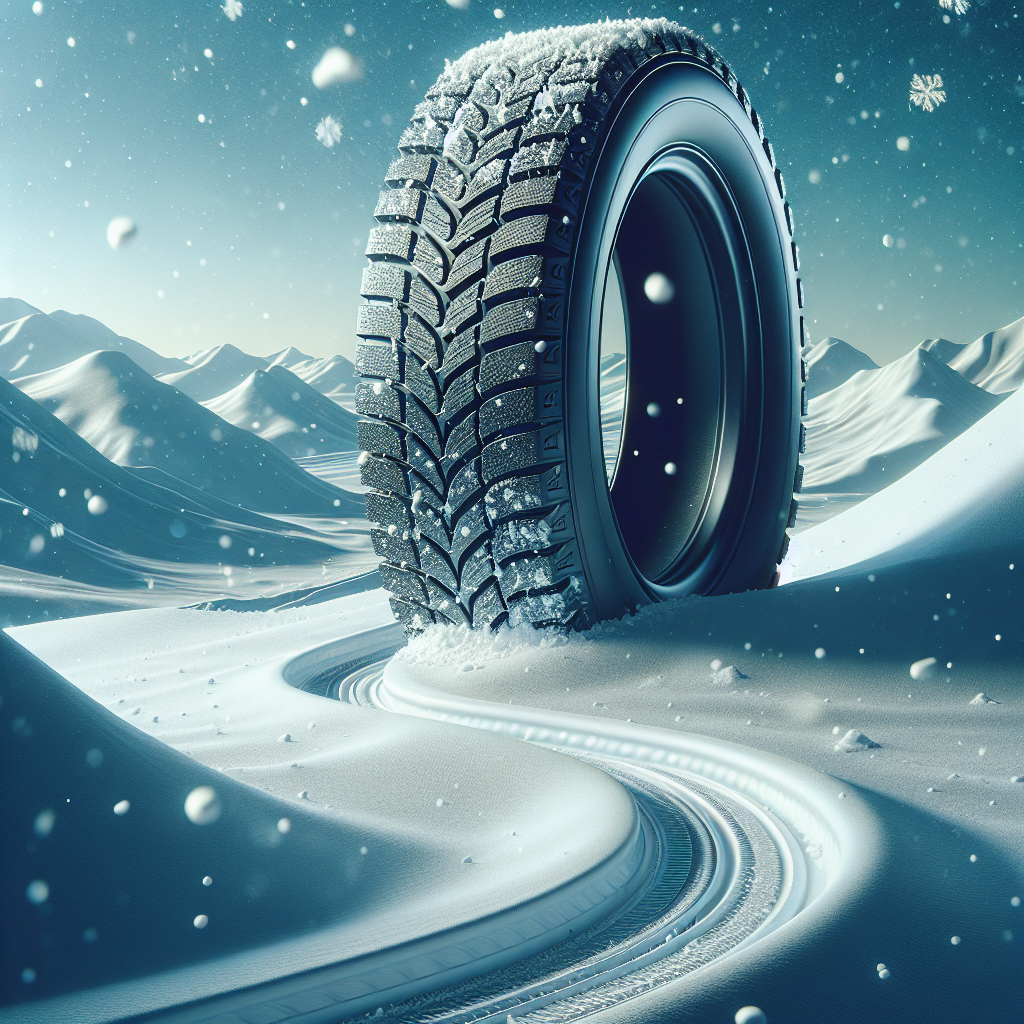Winter tires are an essential companion for any driver facing the challenges of mountainous terrain and winding roads. With their special tread patterns and superior grip on icy and snowy surfaces, these tires ensure a safe and confident drive, even in the harshest winter conditions. So, if you’re planning a trip to the mountains or regularly commute on twisted roads during the colder months, it’s time to learn about the exceptional performance of winter tires.

Benefits of Winter Tires in Mountainous Terrain and Winding Roads
Improved Traction
Winter tires provide improved traction in mountainous terrain and winding roads due to their unique tread design and specialized rubber compounds. The tread patterns of winter tires are designed to bite into snow and ice, providing increased grip and traction. This allows for better acceleration, cornering, and overall control of your vehicle. With winter tires, you can navigate through slippery and challenging road conditions with ease.
Enhanced Handling and Control
One of the key benefits of using winter tires in mountainous terrain and winding roads is the enhanced handling and control they offer. With their improved grip, winter tires provide better steering response and stability. This is particularly important when you encounter sharp turns and curves, as winter tires can help you maintain control of your vehicle and navigate safely through these challenging road conditions. It gives you the confidence to tackle even the toughest roads.
Reduced Risk of Accidents
Winter tires play a crucial role in reducing the risk of accidents in mountainous terrain and winding roads. The improved traction and handling offered by these tires significantly enhance your vehicle’s stability and control, reducing the chances of skidding or sliding off the road. With winter tires, you are less likely to lose control of your vehicle, even in slippery conditions. This increased safety factor is especially important when driving on roads where there is limited room for error.
Superior Braking Performance
Winter tires are designed to provide superior braking performance in mountainous terrain and winding roads. The unique tread patterns and rubber compounds of these tires allow them to effectively grip the road surface, even in cold and icy conditions. This means shorter braking distances and quicker stops, which can be vital when faced with sudden obstacles or the need to react to other drivers on treacherous roads. Winter tires give you added peace of mind, knowing that you can stop safely and in time when you need to.
Factors to Consider When Choosing Winter Tires
Tire Size and Type
When choosing winter tires for mountainous terrain and winding roads, it is essential to consider the appropriate tire size and type for your vehicle. The right tire size ensures optimal performance and compatibility with your vehicle’s specifications. Additionally, you must determine whether you need studless or studdable winter tires based on your driving needs and local regulations.
Tread Pattern and Depth
The tread pattern and depth of winter tires are critical factors to consider. A good winter tire should have deep and aggressive tread patterns that help evacuate snow and slush, providing maximum traction on slippery surfaces. Look for tires with wide grooves and sipes that create biting edges and enhance grip. It is also important to monitor the wear of the tread as it affects the tire’s performance in snowy and icy conditions.
Rubber Compound
The rubber compound of a winter tire plays a significant role in its performance in mountainous terrain and winding roads. Winter tires are made from a rubber compound that remains flexible in cold temperatures, allowing the tire to maintain grip on icy and snowy roads. Look for tires with a high-quality rubber compound that is specifically formulated for winter driving conditions.
Studdable vs. Studless Tires
When choosing winter tires for mountainous terrain and winding roads, you must decide between studdable and Studless tires. Studless tires are designed with advanced tread designs and rubber compounds to provide excellent traction without the need for metal studs. Studdable tires, on the other hand, allow for the installation of metal studs to enhance traction on icy surfaces. Consider your driving needs, local regulations, and the conditions you commonly encounter to decide which option is best for you.
Load Index and Speed Rating
Before purchasing winter tires, it is essential to check the load index and speed rating. These ratings indicate the maximum load-carrying capacity and maximum speed capability of the tires, respectively. Ensure that the winter tires you choose are suitable for the weight of your vehicle and comply with the speed limits you typically encounter on mountainous terrain and winding roads.
Impact of Weather and Temperature
Cold Weather Performance
Winter tires are specifically designed to perform well in cold weather conditions, making them ideal for mountainous terrain and winding roads. As temperatures drop, the rubber compounds used in winter tires remain soft, providing excellent grip and traction. This allows the tires to maintain their performance even in freezing temperatures, ensuring you can navigate challenging road conditions with confidence.
Snow and Ice Performance
Snow and ice are common challenges you may encounter in mountainous terrain and winding roads. Winter tires excel in these conditions due to their specialized tread patterns and rubber compounds. The aggressive tread patterns efficiently bite into snow, providing enhanced traction and control. Additionally, the flexible rubber compounds allow the tires to conform to icy surfaces, maintaining grip and reducing the risk of sliding or skidding. With winter tires, you can confidently tackle snowy and icy roads, knowing that your tires will perform optimally.
Effect of Tire Pressure and Maintenance
Proper Inflation
Maintaining proper tire pressure is essential for winter tire performance in mountainous terrain and winding roads. Cold temperatures can cause tire pressure to drop, so it is important to regularly check and inflate the tires to the manufacturer’s recommended levels. Properly inflated tires ensure optimal contact with the road, maximizing grip and traction. Moreover, the risk of tire damage or blowouts is reduced when tires are properly inflated.
Regular Inspection, Rotation, and Alignment
Regular inspection, rotation, and alignment are crucial to ensure the longevity and performance of your winter tires. Inspect the tires for signs of wear, bulges, or cuts, as damaged tires can compromise their performance and safety. Rotating the tires at regular intervals promotes even wear, extending their lifespan. Additionally, proper wheel alignment improves handling and reduces unnecessary strain on the tires. Regular maintenance practices will contribute to optimal winter tire performance on mountainous terrain and winding roads.
Tire Pressure Monitoring System (TPMS)
Investing in a Tire Pressure Monitoring System (TPMS) can greatly benefit winter tire performance. A TPMS continuously monitors the tire pressure and alerts you if there is significant underinflation or overinflation. This allows you to promptly address any tire pressure issues. By maintaining the proper tire pressure consistently, you can ensure the best possible performance of your winter tires in mountainous terrain and winding roads.

Testimonials and Reviews
Experiences of Drivers in Mountainous Terrain
Reading testimonials and reviews from drivers who have experience in mountainous terrain can provide valuable insights when choosing winter tires. These firsthand accounts can provide information on how the tires performed in challenging conditions, including their traction, handling, and braking capabilities. Consider the experiences of others who have driven on similar roads to help inform your decision.
Professional Reviews and Ratings
Professional reviews and ratings from reputable sources can also be instrumental in choosing winter tires for mountainous terrain and winding roads. Experts conduct thorough tests and evaluations, assessing various factors such as wet and dry grip, snow and ice performance, handling, and braking. Their unbiased opinions can guide you towards the winter tires that excel in the specific conditions you will be driving in.
Best Winter Tires for Mountainous Terrain and Winding Roads
Brand A’s Winter Tire Model X
Brand A’s Winter Tire Model X is a top contender for mountainous terrain and winding roads. With its deep tread pattern and advanced rubber compound, it provides excellent traction and control in snow and icy conditions. The tire’s aggressive shoulder blocks enhance cornering stability, allowing you to navigate sharp turns with confidence. Brand A’s Winter Tire Model X has received positive reviews and ratings for its superior winter performance, making it a reliable choice for challenging road conditions.
Brand B’s Winter Tire Model Y
Brand B’s Winter Tire Model Y is another excellent option for mountainous terrain and winding roads. Its unique tread design features robust blocks and multiple sipes, ensuring optimal grip on snow and ice. The tire’s flexible rubber compound maintains performance in low temperatures, delivering enhanced traction and handling. Brand B’s Winter Tire Model Y has been praised for its exceptional winter capabilities and durability, making it a popular choice among drivers tackling challenging roads.
Brand C’s Winter Tire Model Z
Brand C’s Winter Tire Model Z is a highly recommended option for mountainous terrain and winding roads. Equipped with an aggressive tread pattern and specialized rubber compound, it provides excellent snow and ice traction. The tire’s optimized contact patch and enhanced grooving offer superior hydroplaning resistance and stability on wet roads. Brand C’s Winter Tire Model Z has garnered positive reviews for its exceptional performance and reliability in winter driving conditions.

Driving Tips for Mountainous Terrain and Winding Roads
Reduce Speed and Avoid Sudden Movements
When driving in mountainous terrain and on winding roads, it is essential to reduce your speed and avoid sudden movements. The unpredictable nature of these roads requires you to be attentive and prepared for any sharp turns or unexpected obstacles. By reducing your speed and avoiding sudden movements, such as hard braking or aggressive steering, you can maintain control of your vehicle and react appropriately to the road conditions.
Maintain a Safe Distance
Keeping a safe distance from the vehicle ahead of you is crucial when driving in mountainous terrain and winding roads. The minimal room for error on these roads means that maintaining a safe distance is even more important. This allows you ample time to react to any sudden stops or potential hazards ahead. Leave enough space between you and the vehicle in front to ensure a safe and controlled driving experience.
Use Low Gears and Downshift
Downshifting to lower gears can provide added control and stability when driving in mountainous terrain and on winding roads. By using low gears, you can slow down the vehicle without solely relying on the brakes. This technique helps to prevent overheating of the brake pads and provides more control over acceleration and deceleration in challenging road conditions. Downshifting effectively when approaching turns or steep inclines can help you maintain a safe and controlled speed.
Anticipate Turns and Curves
Anticipating turns and curves is key to navigating mountainous terrain and winding roads safely. Paying close attention to the road ahead and being aware of upcoming turns allows you to adjust your speed and position accordingly. Slow down before entering a curve and maintain a consistent speed throughout to ensure stability. By anticipating turns and curves, you can maintain control of your vehicle and smoothly navigate through the challenging road conditions.
Installing Winter Tires for Optimal Performance
Changing All Four Tires
When installing winter tires for optimal performance in mountainous terrain and winding roads, it is recommended to replace all four tires. Maintaining an evenly matched set of winter tires ensures consistent performance and balanced traction. Mixing different tire types or using winter tires only on the front or rear can compromise your vehicle’s handling and stability. Installing a complete set of winter tires will maximize their effectiveness and ensure optimal performance.
Rotating Front and Rear Tires
Rotating the front and rear tires is another option to consider when installing winter tires. This practice promotes even wear and extends the lifespan of the tires. By Rotating the tires, you distribute the forces evenly, preventing excessive wear on certain areas. Consult your vehicle’s manual or a tire professional for the recommended rotation pattern. Regularly rotating your winter tires will help maintain their performance and ensure a smooth driving experience on mountainous terrain and winding roads.
Professional Installation and Balancing
To ensure the optimal performance of your winter tires, it is recommended to have them professionally installed and balanced. Professional installation ensures that the tires are mounted correctly, and the appropriate torque is applied to the lug nuts. Moreover, professional balancing eliminates any uneven weight distribution, which can cause vibrations and adversely affect the tire’s performance. By entrusting the installation and balancing to a qualified tire technician, you can have peace of mind knowing that your winter tires are properly installed and ready to tackle mountainous terrain and winding roads.

Comparing Winter Tires to All-Season Tires
Handling and Traction Differences
Winter tires and all-season tires differ significantly in their handling and traction capabilities. While all-season tires offer decent performance in a variety of weather conditions, they are not specifically designed for the extreme winter conditions encountered in mountainous terrain and on winding roads. Winter tires, on the other hand, provide superior grip on snow and ice due to their specialized tread patterns, rubber compounds, and biting edges. When it comes to handling and traction in challenging winter conditions, winter tires outperform all-season tires, making them the safer and more reliable choice for mountainous terrain and winding roads.
Performance in Extreme Winter Conditions
When it comes to extreme winter conditions, winter tires shine in comparison to all-season tires. In mountainous terrain and on winding roads, you may encounter deep snow, slippery ice, and freezing temperatures. Winter tires are specifically engineered to handle these conditions, offering exceptional performance and safety. Their deep tread patterns efficiently evacuate snow and slush, while their specialized rubber compounds remain flexible in cold temperatures, maintaining optimal grip. All-season tires, while suitable for mild winter conditions, lack the specialized capabilities of winter tires and may struggle to provide adequate traction on icy or snow-covered roads.
Cost Considerations and Longevity
Initial Cost and Investment
When considering winter tires for mountainous terrain and winding roads, it is important to factor in the initial cost and investment. Winter tires can be more expensive than all-season tires due to their specialized design and capabilities. However, it is crucial to remember that the cost is an investment in safety and improved performance. The enhanced traction, handling, and control provided by winter tires can significantly reduce the risk of accidents and potential damage to your vehicle. Ultimately, the initial cost of winter tires is a small price to pay for the added safety and peace of mind they offer on challenging roads.
Longevity and Durability
Longevity and durability are essential considerations when evaluating the cost of winter tires. Winter tires are typically made from materials that are designed to withstand harsh winter conditions, making them more durable than all-season tires in low temperatures. However, it is important to note that winter tires may wear faster on dry and warm pavement due to their specialized rubber compounds. To maximize the lifespan of your winter tires, it is crucial to install them during the winter season and switch back to all-season tires once the temperatures rise. Proper tire maintenance, regular rotation, and monitoring the tread wear will also contribute to their longevity and durability.
Retreadability for Extended Life
Another consideration for the longevity of winter tires is their retreadability. Some winter tires are designed to be retreaded, which involves replacing the worn-out tread with a new layer of rubber. Retreading can extend the life of your winter tires, making them a more cost-effective choice over the long run. However, not all winter tires are retreadable, so it is important to check the manufacturer’s specifications and inquire with a tire professional before making a purchase. Retreadability can offer significant savings by allowing you to get more use out of your winter tires, making them an economical option for drivers in mountainous terrain and on winding roads.
In conclusion, winter tires offer numerous benefits when driving in mountainous terrain and on winding roads. Their improved traction, enhanced handling and control, reduced risk of accidents, and superior braking performance make them a must-have for navigating challenging winter conditions. When choosing winter tires, factors such as tire size and type, tread pattern and depth, rubber compound, studdable vs. studless options, and load index and speed rating should be considered. The impact of weather and temperature, tire pressure and maintenance, as well as testimonials, reviews, and professional ratings, also play a significant role in selecting the right winter tires. Brands like A, B, and C each offer reliable winter tire models suitable for mountainous terrain and winding roads. To fully optimize the performance of winter tires, it is important to drive cautiously, maintain proper tire pressure, and inspect, rotate, and align the tires regularly. Installing all four winter tires, rotating front and rear tires, and seeking professional installation and balancing are also recommended. Comparing winter tires to all-season tires highlights the differences in handling, traction, and performance in extreme winter conditions, ultimately showcasing the superiority of winter tires. Considering the initial cost and investment, longevity and durability, as well as the retreadability of winter tires, will help drivers make an informed decision. With the right winter tires and driving techniques, drivers can confidently navigate mountainous terrain and winding roads, ensuring safety and peace of mind even in challenging winter conditions.


